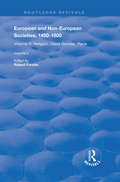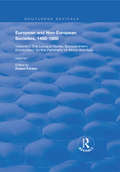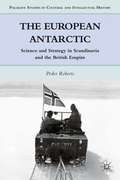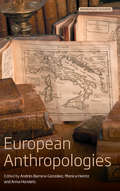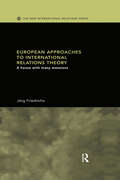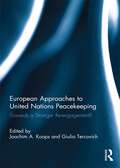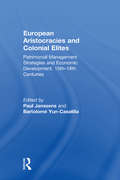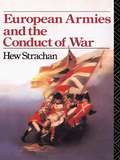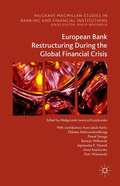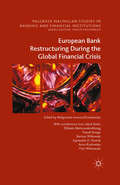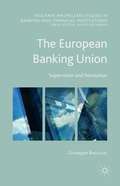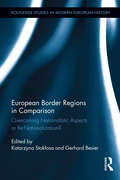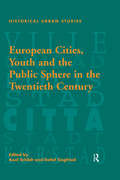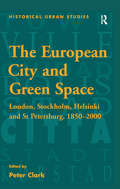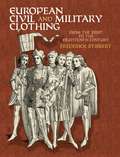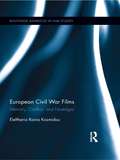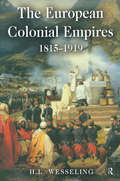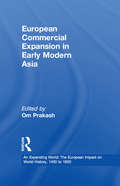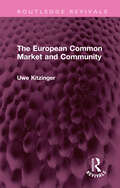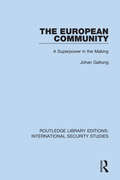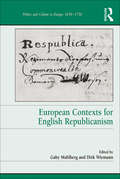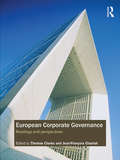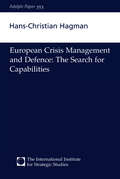- Table View
- List View
European and Non-European Societies, 1450-1800: Volume II: Religion, Class, Gender, Race (Routledge Revivals)
by Robert ForsterFirst published in 1997, this volume looks at the process of European expansion which brought into contact societies and cultures across the world which had been initially alien to one another. Conflict was one aspect of this interaction, but accommodation, mutual adaptation, and institutional and behavioural synthesis were also present though often biased in favour of European norms. The intent of this book is to avoid treating ’colonization’, ’dominance’ and exploitation’ as the only focuses of attention. The second volume focuses on the Americas, and uses the topics of religion, class, gender, and race as its points of entry.
European and Non-European Societies, 1450–1800: Volume I: The Longue Durée, Eurocentrism, Encounters on the Periphery of Africa and Asia (Routledge Revivals)
by Robert ForsterFirst published in 1997, this is the first of two volumes. It looks at the process of European expansion which brought into contact societies and cultures across the world which had been initially alien to one another. Conflict, and violent conflict, was one aspect of this interaction, but accommodation, mutual adaptation, and institutional and behavioural synthesis were also present though often biased in favour of European norms. The intent of this book is to avoid treating ’colonization’, ’dominance’ and exploitation’ as the only focuses of attention. In the first volume Robert Forster explores issues of formative influences, the impact of Eurocentrism on historiography and the reaction against it, and the differing approaches and perceptions of the Europeans, notably the Spanish, French and English. In this period he distinguishes three modes of interaction: that of the trading empires, generally in Africa and Asia, where the European control of the encounter was slighter; and those of the regions of settlement, as in North America, and of exploitation, typified by the Caribbean, where the European impact was profound. The second volume focuses on the Americas, and uses the topics of religion, class, gender, and race as its points of entry.
The European Antarctic
by Peder RobertsThis is the first transnational study of British, Norwegian, and Swedish engagement with the Antarctic. Rather than charting how Europeans unveiled the Antarctic, it uses the history of Antarctic activity as a window into the political and cultural worlds of twentieth-century Britain and Scandinavia.
European Anthropologies
by Andrés Barrera-González Monica Heintz Anna HoroletsIn what ways did Europeans interact with the diversity of people they encountered on other continents in the context of colonial expansion, and with the peasant or ethnic 'Other' at home? How did anthropologists and ethnologists make sense of the mosaic of people and societies during the nineteenth and twentieth centuries, when their disciplines were progressively being established in academia? By assessing the diversity of European intellectual histories within sociocultural anthropology, this volume aims to sketch its intellectual and institutional portrait. It will be a useful reading for the students of anthropology, ethnology, history and philosophy of science, research and science policy makers.
European Approaches to International Relations Theory: A House with Many Mansions (New International Relations)
by Jörg FriedrichsA well-established community of American scholars has long dominated the discipline of international relations. Recently, however, certain strands of continental theorizing are being introduced into the mainstream. This is a critical examination of European approaches to international relations theory, suggesting practical ways of challenging manistream thought. Freidrichs presents a detailed sociological analysis of knowledge production in existing European IR communities, namely France, Italy and Scandinavia. He also discusses a selection of European schools and approaches.
European Approaches to United Nations Peacekeeping: Towards a stronger Re-engagement?
by Christian Breunig, Christine S. Lipsmeyer and Guy D. WhittenThis edited volume provides a comprehensive analysis of European approaches to United Nations peacekeeping by assessing past practice, present obstacles and future potentials related to nine core European countries’ contributions to blue helmet operations. By providing in-depth case studies on Denmark, France, Germany, Ireland, Italy, Norway, Sweden, The Netherlands and the United Kingdom, this book offers an evaluation of European approaches as well as a wide range of facilitating and constraining factors related to the above mentioned countries’ future involvement in UN peacekeeping. The book places particular emphasis on the recent involvement of European countries in the UN operation in Mali (MINUSMA) and explores to what extent this experience might lead to further marked increases of European supplies of troops and capabilities and thus a broader ‘European return’ to UN peacekeeping. Each chapter offers an up-to-date case study on key countries’ policies, challenges and opportunities for a stronger re-engagement in UN Peacekeeping It provides a comprehensive analysis of the main challenges and concrete ways ahead for overcoming institutional, political, financial and military obstacles (both at European capitals and within the UN system) on the path towards a stronger re-engagement of European troop contributing countries in the field of UN Peacekeeping. Furthermore, each chapter includes a set of policy-relevant recommendations for future ways ahead. The chapters in this book were originally published in International Peacekeeping.
European Aristocracies and Colonial Elites: Patrimonial Management Strategies and Economic Development, 15th–18th Centuries
by Paul Janssens Bartolomé Yun-Casalilla'Aristocracies', 'Old Regime colonial elites' - from Adam Smith to Karl Marx and beyond, scholars have discussed their role in the rise of the modern world, in economic development and capitalism. Generally speaking and with the exception of the English landlords, the verdict has been always negative. Furthermore, historians have usually viewed the Ancien régime aristocracies and colonial elites as social groups with entirely irrational or completely apathetic attitudes towards the management of their estates. This book constitutes the first attempt to analyse the question in a more critical and historical way. It takes a directly comparative approach, covering countries from Peru to Russia and from Naples to England in the early modern period and up to the end of the 18th century. The rationale of how these elites administered their patrimonies, its political, social and sometime moral dimensions, and the real effects of all this on economic development are considered here as key aspects for a better understanding of economic life. The result is a quite different picture in which economic history is also seen as the outcome of human actions in their own social and political context.
European Armies and the Conduct of War
by Hew StrachanDiscussing the key issues of modern warfare, Hew Strachan’s work examines the theory and practice of land warfare in Europe since 1700. Looking at warfare in the context of social and political change, Dr. Strachan interprets his subject matter as widely as possible, and European Armies and the Conduct of War considers the roles of air power and the impact of the United States on European military developments. Through the eyes of the major theorists of the day, European Armies examines: * how the social and political influences which shape armies, also mould the attitude of those armies to warfare* the story of techicnal innovation* the mounting pace of industrialization and its impact of warfare. Recent military history has tended to focus on the relationship between armies and society and there has been much original research on the subject of the conduct of war. This book brings these approaches together, providing information and insight vital to the study of this fascinating era.
European Bank Restructuring During the Global Financial Crisis (Palgrave Macmillan Studies in Banking and Financial Institutions)
by Jakub Kerlin Małgorzata Iwanicz-Drozdowska Paweł Smaga Bartosz Witkowski Anna Kozłowska Elżbieta Malinowska-Misiąg Agnieszka Nowak Piotr WisniewskiThis book explores the diversity of restructuring instruments applied to financial institutions in EU countries during the Global Financial Crisis. It investigates the cost of that support before evaluating its effects, as well as providing an extensive analysis of the measures undertaken. The first chapter presents a historical outline, discusses causes of crises, and offers an overview of the restructuring instruments and of how they were used for crisis management before 2007. The following chapters explore the financial environment in the EU before the crisis outbreak, the rescue actions and financial landscape after the events of the crisis. This book offers a critical and thorough analysis of the financial support provided to banks, providing case studies of over 95 banks from 17 EU member states. The authors provide an in-depth study of the pre and post-crisis landscape, and demonstrate that the crisis has by no means been overcome.
European Bank Restructuring During the Global Financial Crisis (Palgrave Macmillan Studies in Banking and Financial Institutions)
by Jakub Kerlin Elżbieta Malinowska-Misiąg Paweł Smaga Bartosz Witkowski Agnieszka K. Nowak Anna Kozłowska Piotr WiśniewskiThis book explores the diversity of restructuring instruments applied to financial institutions in EU countries during the Global Financial Crisis. It investigates the cost of that support before evaluating its effects, as well as providing an extensive analysis of the measures undertaken. The first chapter presents a historical outline, discusses causes of crises, and offers an overview of the restructuring instruments and of how they were used for crisis management before 2007. The following chapters explore the financial environment in the EU before the crisis outbreak, the rescue actions and financial landscape after the events of the crisis. This book offers a critical and thorough analysis of the financial support provided to banks, providing case studies of over 95 banks from 17 EU member states. The authors provide an in-depth study of the pre and post-crisis landscape, and demonstrate that the crisis has by no means been overcome.
The European Banking Union: Supervision And Resolution (Palgrave Macmillan Studies in Banking and Financial Institutions)
by Giuseppe BoccuzziThe 2008 financial crisis all but brought down the financial system and real economies of industrial countries. The Banking Union took a broad approach to resolve the structural fragmentation and distortions in the European banking system which were major obstacles to a working single market for financial services. This book examines the numerous changes happening to European legislations for the prevention and management of banking crises. What emerges is a changing picture of regulations and institutions, of goals, tools and opinions, public and private, European and national all involved in the task. The book focuses on the new framework for banking crisis management, starting from the foundations of banking regulation and supervision. It explores the institutional architecture of banking supervision and crisis management, the powers of the authorities, the tools for administrative actions, the complexities of business and bankruptcy laws, individual rights and their legal guarantees.
European Border Regions in Comparison: Overcoming Nationalistic Aspects or Re-Nationalization? (Routledge Studies in Modern European History #21)
by Gerhard Besier Katarzyna StokłosaBorders exist in almost every sphere of life. Initially, borders were established in connection with kingdoms, regions, towns, villages and cities. With nation-building, they became important as a line separating two national states with different “national characteristics,” narratives and myths. The term “border” has a negative connotation for being a separating line, a warning signal not to cross a line between the allowed and the forbidden. The awareness of both mental and factual borders in manifold spheres of our life has made them a topic of consideration in almost all scholarly disciplines – history, geography, political science and many others. This book primarily incorporates an interdisciplinary and comparative approach. Historians, sociologists, anthropologists and political science scholars from a diverse range of European universities analyze historical as well as contemporary perceptions and perspectives concerning border regions – inside the EU, between EU and non-EU European countries, and between European and non-European countries.
European Cities, Youth and the Public Sphere in the Twentieth Century (Historical Urban Studies Series)
by Detlef SiegfriedThe late nineteenth century witnessed unprecedented levels of urban growth as migration swelled the population of European cities to new heights. The resulting problems of overcrowding and inadequate civic utilities prompted the governing elites to look for new planning solutions to address the needs of an increasingly urbanised society. At the same time young people were also increasingly recognised as being adversely affected, both politically and morally, by the on-going process of urbanization. Church groups, civic authorities, middle-class reformers and political movements all tried to steer youth toward their own concept of respectable behaviour, concepts that often tended to share many similarities in their paternalistic emphasis upon social discipline. This volume directly addresses the confluence of these issues, the point at which the city government, youth and public space meet and the resulting problems and tensions that were often created. Whether it be the corruption of the rural youth flooding into the cities at the beginning of the twentieth century, battles between Hitler Youth and working-class gangs in Nazi Germany, hooliganism in 1950s Hungary or the appropriation of, or withdrawal from, public spaces by youths in more recent times, all the chapters in this book explore ways in which authorities and adult groups have sought to control young people, both directly and indirectly. Drawing on a broad selection of methods and disciplines, a wide variety of case studies from across Europe are used to investigate the interactions between youth and authority, and show how these adapted and changed over time and in different countries. By taking a fresh look at these issues within a comparative framework, this volume furthers our understanding of modern European society during the twentieth century.
The European City and Green Space: London, Stockholm, Helsinki and St Petersburg, 1850–2000 (Historical Urban Studies Series)
by Peter ClarkRecent years have seen sustained public debate and controversy over the 'greening' of European cities, associated with the environmental movement, pressures of urban redevelopment, and the promotional strategies of cities competing in a global market. But the European debate over urban green space has a long history dating back to Victorian concerns for the 'green lungs' of the city to combat the health and social problems caused by rapid population and industrial growth. This book explores the multiplicity of green space developments in the modern city - ranging over parks and commons, garden suburbs and the cities in the park, allotment gardens, green belts and national urban parks. It is concerned not only with the different types of green space but the many influences shaping their evolution, from international planning ideas, to the rise of modern-day sport and leisure, and the effects of the transport revolution. No less vital in this story is the interaction of the many actors involved in the often fractious political process of creating green spaces - architects and planners, politicians, developers and other businessmen, NGOs and local residents. This volume is particularly concerned with contexts: how international planning ideas are transmitted and adapted in different European cities; how the construction of green space is affected by local power structures and relationships; and how ordinary people perceive and use green spaces, quite often at variance with official designs. The European City and Green Space looks at these and other issues through the prism of four metropoles - London, Stockholm, Helsinki and St Petersburg. All represent different types of North European city, yet each has experienced distinctive economic, political and cultural trajectories, whilst also facing powerful challenges and problems of similar kinds with regard to green space. This volume examines how each has responded to them and what patterns emerge.
European Civil and Military Clothing: From The First To The Eighteenth Century (Dover Fashion and Costumes)
by Sir Frederic StibbertA wealthy Anglo-Italian connoisseur devoted to the nineteenth-century struggle for Italian unification, Frederick Stibbert amassed an extensive collection of arms, armor, and costume -- which today can be found in the Tuscan museum bearing his name. During the years in which he built up the museum's collection, he examined countless illuminated manuscripts, ancient documents, frescoes, paintings, and other records of armor and dress.The illustrations in this book, based on exceptional drawings by Stibbert himself and engraved by leading craftsmen of the day, reveal a remarkable panorama of European costume history. The volume contains 217 handsome plates depicting nearly 1,000 individual figures and their accessories, all scrupulously accurate and rendered in meticulous detail. Here are excellent illustrations of priests, warriors, Roman citizens, and women of ancient Britain; the German Emperor Otto and his wife; French monarchs and Scottish kings; jousting English knights of the thirteenth century; fifteenth-century Italian gentlewomen; elaborately coiffed ladies from the court of Versailles; and much more. Captions give the origins of the armor and dress, the sources of the drawings, precise descriptions of each item represented, and explanations of the function and manner of wearing armor.This extraordinary work has wide appeal: fashion historians will be attracted by its scrupulous accuracy and the authenticity of the garments; the royalty-free illustrations will be prized by artists and illustrators; and the handsome engravings and informative captions will entertain and instruct readers interested in the history of costume.
European Civil War Films: Memory, Conflict, and Nostalgia (Routledge Advances in Film Studies)
by Eleftheria Rania KosmidouThis book examines the ways in which late twentieth-century European cinema deals with the neglected subject of civil war. Exploring a range of films about the Spanish, Irish, former Yugoslavia, and Greek civil wars, this comparative and interdisciplinary study engages with contemporary debates in cultural memory and investigates the ways in which cinematic postmemory is problematic. Many of the films present an idealized past that glosses over the reality of these civil wars, at times producing a nostalgic discourse of loss and longing. Other films engage with the past in a melancholic fashion. These cinematic discourses articulate contemporary concerns, especially the loss of ideology and a utopian political horizon in the aftermath of the collapse of the Soviet bloc in 1989, a date that marks a significant break in European history and an accompanying paradigm shift in European cultural memory. Filmmakers examined include Trueba, Cuerda, Loach, Jordan, Kusturica, Dragojević, and Angelopoulos.
The European Colonial Empires: 1815-1919 (Studies In Modern History)
by H. L. WesselingThe nineteenth century was Europe's colonial century. At the beginning of the period, the only colonial empire that existed was the British Empire. By the end of the century the situation was completely different and Europe's colonial possessions had come to constitute a large part of the world. The French had acquired an immense colonial empire and the Dutch had extended their control over Indonesia. Germany and Italy, unified only in the latter half of the century, had claimed their place under the sun. Even the tiny Kingdom of Belgium had acquired a huge colonial territory in Africa: the Belgian Congo. This is the first book to describe the whole process of colonization from conquest to pacification, and to analyze it in the light of administrative, cultural and economic developments. The European Colonial Empires discusses a uniquely long period instead of merely focussing on the shorter, accepted age of classical imperialism. Wesseling argues that European colonial expansion can be understood only by putting it into this long-term perspective and by comparing the differences between the colonies in Africa, Asia, Oceania and the Caribbean. This book redresses the balance that privileges the British colonial and imperial experience. It emphasizes the continental European experience while relating developments to the British enterprise.
European Colonialism since 1700
by James R. LehningThis masterful synthesis provides a much-needed, complete survey of European colonialism from 1700 to decolonization in the twentieth century. Written by an award-winning author, this advanced undergraduate and graduate level textbook bridges, for the first time, the early modern Atlantic empires and the later Asian and African empires of 'high imperialism'. Viewing colonialism as a phenomenon of contact between Europe and the rest of the world, the author takes an 'entangled histories' approach, considering the surprising ways in which the imperial powers of Spain, Portugal, Great Britain, France and the Netherlands displayed their identities in colonial settings, as much as in their imperial capitals. The author illuminates for students the common themes of colonial government, economic development and cultural contact across empires, and reveals the ways in which these themes played out, through contrast of the differing development, structure and impact of each empire.
European Commercial Expansion in Early Modern Asia (An Expanding World: The European Impact on World History, 1450 to 1800 #10)
by Om PrakashRegular commercial contacts between Europe and Asia date back to at least the early years of the Christian era, but the pattern of trade underwent a structural modification following the Portuguese discovery of a route to the East Indies via the Cape of Good Hope. This volume illustrates the consequences of the arrival of large numbers of Europeans in the East. Europeans both participated in, modified and exploited existing trade relationships in the Indian Ocean and the Pacific. The studies reprinted here show how some environments, such as Japan, were hostile, whilst most states welcomed the European commercial contact. The necessity for Europeans to pay for Asian goods using precious metals is emphasised by the inclusion of articles in monetary transfers in Asian trade, a phenomenon which provides a link between economic developments in the Americas and those in Asia from the 16th century onwards.
The European Common Market and Community (Routledge Revivals)
by Uwe KitzingerOriginally published in 1967, though with an enduring relevance as Britain once again navigates its role outside the EU, this book is a selection of documents which illustrate how the former European Economic Community came into being. The reader is invited to make up their mind about the arguments for and against British participation in the Common Market. The author introduces his evidence with an historical interpretation of the situation and concludes with an assessment of the significance of the Community concept in the world as well as in Europe.
The European Community: A Superpower in the Making (Routledge Library Editions: International Security Studies #7)
by Johan GaltungThis book, first published in 1973, analyses the European Community in a global perspective. It asks and answers two main questions: what does the European Community mean to the masses of the world, and what does it mean to the world community in general? Most critical studies of the EC were made from an internal point of view, and this book is rare in having an external perspective. The author discussed the EC with diverse audiences in 16 countries, and his analyses are invaluable in putting the European project in an international context.
European Contexts for English Republicanism (Politics and Culture in Europe, 1650-1750)
by Gaby Mahlberg Dirk WiemannEuropean Contexts for English Republicanism offers new perspectives on early modern English republicanism through its focus on the Continental reception of and engagement with seventeenth-century English thinkers and political events. Looking both at political ideas and at the people that shaped them, the collection examines English republican thought in its wider European context during the later seventeenth and eighteenth century. In a number of case studies, the contributors assess the different ways in which English republican ideas were not only shaped by the thought of the ancients, but also by contemporary authors from all over Europe, such as Hugo Grotius or Christoph Besold. They demonstrate that English republican thinkers did not only act in dialogue with Continental authors and scholars, their ideas in turn also left a long-lasting legacy in Europe as they were received, transformed and put to new uses by thinkers in France, Italy, the Netherlands, Germany and Poland. Far from being an exclusively transatlantic affair, as much of the established scholarship suggests, English republican thought also left its legacy on the European Continent, finding its way into wider debates about the rights and wrongs of the English Civil War and the nature of government, while later translations of English republican works also influenced the key thinkers of the French Revolution and the liberals of the nineteenth century. Bringing together a range of fresh and original essays by British and European scholars in the field of early modern intellectual history and English studies, this collection of essays revises a one-sided approach to English republicanism and widens the scope of study beyond linguistic and national boundaries by looking at English republicans and their continental networks and legacy.
European Corporate Governance: Readings and Perspectives
by Thomas Clarke Jean-François ChanlatFor decades, Europe has sought to become more financially integrated with the United States and thus European legal institutions, regulatory, governance and accounting practices have faced pressures to adapt to international competitive markets. Against this backdrop, European corporate governance systems have been criticized as being less efficient than the Anglo-American market based systems. This textbook examines the unique dimensions and qualities of European corporate governance. Reforms of key institutions, the doctrine of shareholder value and the seemingly irresistible growth of CEO power and reward are critically analyzed. The book brings out the richness of European corporate governance systems, as well as highlighting historical weaknesses that will require further work for a sustainable corporate governance environment in the future. In light of the most severe financial crisis since the 1930s, this intelligent look at European corporate governance is a vital textbook for courses on corporate governance and a great supplementary textbook on a host of business, management and accounting classes.
European Crisis Management and Defence: The Search for Capabilities (Adelphi series)
by Hans-Christian HagmanAssesses the EU and NATO's tools to prevent conflicts and manage international crises. It offers a unique insight into European security policy and questions the realism of the political goals. It argues for more coordination among European states, and an enhancement of the EU's strategic decision-making capabilities.
